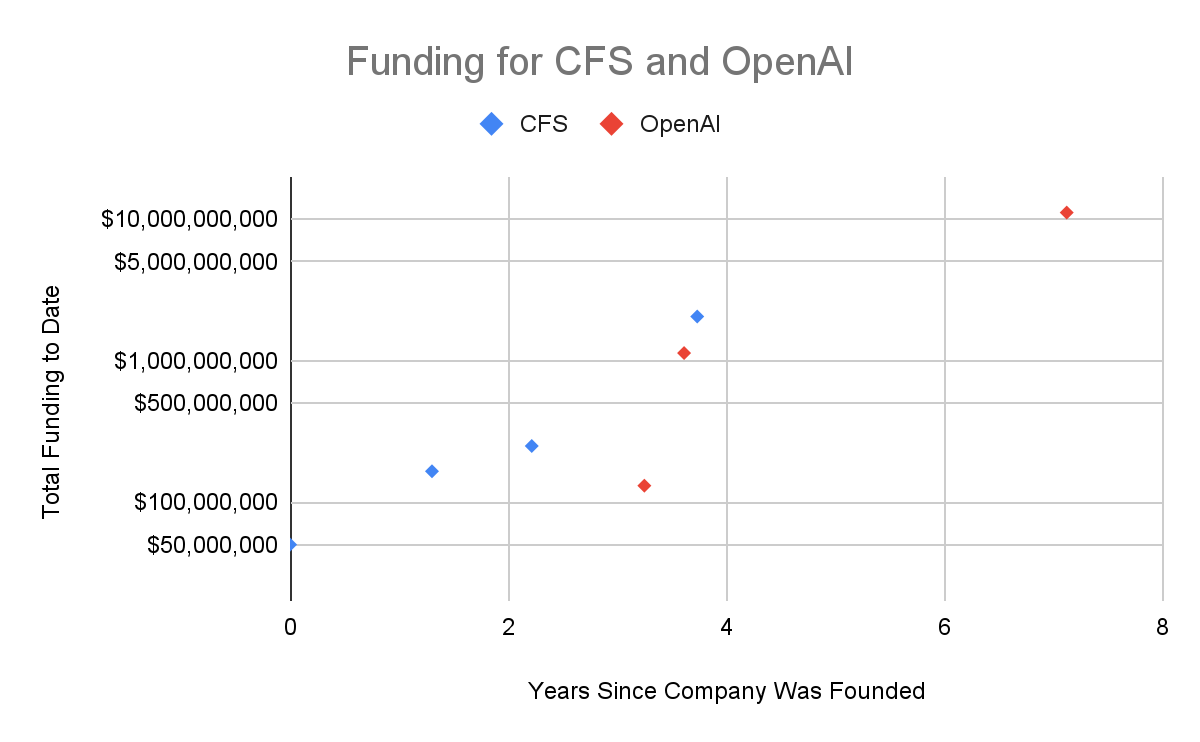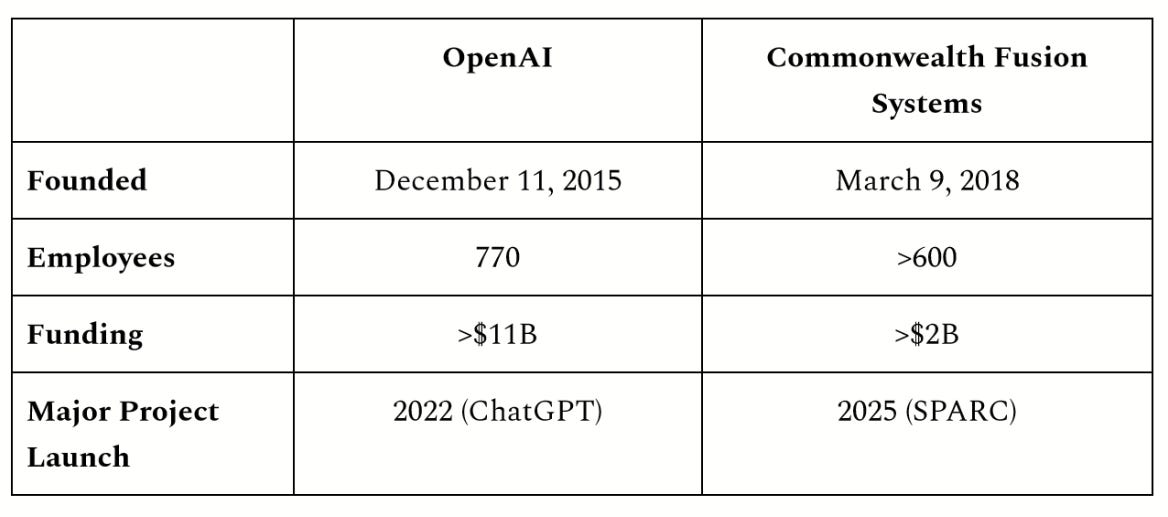Commonwealth Fusion Systems is the Same Scale as OpenAI
Artificial intelligence is not the only exciting emerging technology. Another one that I am personally familiar with is fusion.
It seems interesting to compare companies working on emerging technologies to get a feel for how surprising developments in these companies are. Some startups working on developing AI have grown rapidly, but how surprising is this growth?
The leading startup for AI is OpenAI. The leading startup for fusion is Commonwealth Fusions Systems (CFS). Here is some basic information for these two companies:
OpenAI was founded 2-3 years before Commonwealth Fusion Systems.12 Other than that, their trajectories have been surprisingly similar.
OpenAI currently has 770 employees.3 Commonwealth Fusion Systems currently has “>600 employees and >100 contractors.”4
OpenAI has received about 5 times as much funding as CFS. Most of this money came from a single investment by Microsoft in 2023.5 If we look at OpenAI from 2-3 years ago to control for the different founding dates, then OpenAI had raised less money than Commonwealth Fusion Systems. It would not surprise me if CFS gets significantly more investment in the next several years as well.
The $10B investment in OpenAI occurred after the launch of ChatGPT, 7 years after the company was founded. Commonwealth Fusion Systems’ first major project is SPARC, a tokamak experiment which should be completed in 2025, also 7 years after the company was founded. The goal of SPARC is to demonstrate Q>1, or net energy gain from the plasma,6 as quickly as possible, and then work up to demonstrating Q~10.7 Fusion projects are notorious for falling behind schedule,8 but CFS has maintained its schedule so far and construction is well underway. It is not certain if SPARC will succeed in demonstrating Q>1 in 2025 or 2026, but if they do, they will likely see a significant increase in hype - and funding.
OpenAI was definitely not making a profit as recently as 2022.9 Their revenue has increased dramatically since then,10 so they might be making a profit now. Commonwealth Fusion Systems is definitely not making a profit now.

I’m not entirely sure what conclusions should be drawn from this comparison. It seems easy to overestimate the relative importance of an industry that is dominant locally (either in your city or in your social network) and to be unaware of developments that are more distant from you. OpenAI and CFS are obviously not the only actors in AI and fusion, respectively, and I have not done a systematic comparison between the two fields. The technical details of these two fields are very different and so place different demands on their workforce and capital. Nevertheless, this comparison provides some evidence that investors’ estimates of the value of AI and fusion are not wildly different.
Introducing OpenAI. (December 11, 2015) https://openai.com/blog/introducing-openai.
MIT launches multimillion-dollar collaboration to develop fusion energy. (March 9, 2018) https://www.nature.com/articles/d41586-018-02966-3.
Savov, Vance, & Ludlow. OpenAI Staff Near Total Mutiny With Threat to Join Microsoft. Bloomberg. (November 20, 2023) https://news.bloomberglaw.com/us-law-week/openai-staff-threaten-to-go-to-microsoft-if-board-doesnt-quit.
Dan Brunner. The high magnetic field path to fusion energy. 65th Annual Meeting of the APS Division of Plasma Physics NO05:1. (November 1, 2023)
Bass. Microsoft Invests $10 Billion in ChatGPT Maker OpenAI. Bloomberg. (January 23, 2023) https://www.bloomberg.com/news/articles/2023-01-23/microsoft-makes-multibillion-dollar-investment-in-openai.
Q is the ratio of energy injected into the plasma to the energy produced by fusion. To accommodate inefficiencies in the rest of a fusion power plant, you would typically want to operate at Q>5.
Rodriguez-Fernandez et al. Overview of the SPARC physics basis towards the exploration of burning-plasma regimes in high-field, compact tokamaks. Nuclear Fusion 62.4. (March 1, 2022) https://iopscience.iop.org/article/10.1088/1741-4326/ac1654.
Fusion projects are also often large international collaborations. Missing schedule and budget targets could be because of the institutional structure of many fusion experiments, rather than because of something inherent to fusion technology itself.
Erin Woo & Amir Efrati. OpenAI’s Losses Doubled to $540 Million as It Developed ChatGPT. The Information. (May 4, 2023) https://www.theinformation.com/articles/openais-losses-doubled-to-540-million-as-it-developed-chatgpt.
Amir Efrati. OpenAI’s Revenue Crossed $1.3 Billion Annualized Rate, CEO Tells Staff. The Information. (October 12, 2023) https://www.theinformation.com/articles/openais-revenue-crossed-1-3-billion-annualized-rate-ceo-tells-staff.

